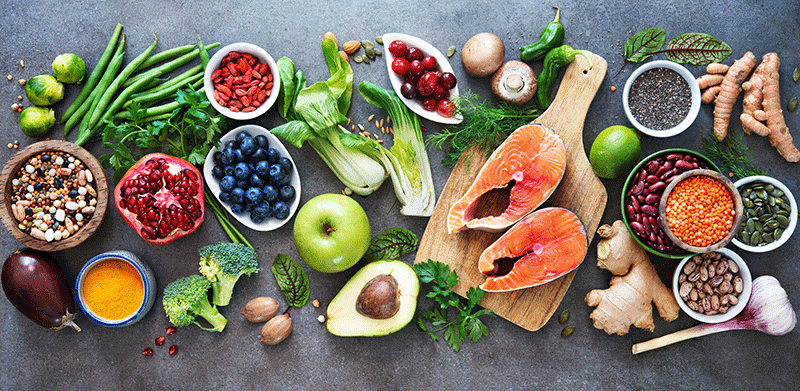How Can I Eat More Nutrient-Dense Foods?

What Does Nutrient-Dense Mean?
Research suggests the standard American diet is energy-rich and nutrient-poor.1 And when we say energy, we mean calories! That’s where the saying “empty calories” comes from — it refers to foods that provide a lot of calories without much nutritional value.
Nutrient-dense foods are rich in vitamins, minerals and other nutrients important for health, without too much saturated fat, added sugars and sodium. We’re talking fruits, vegetables, whole grains, non-fat and low-fat dairy, fish and seafood, unprocessed lean meat and skinless poultry, nuts and legumes.2 You know, the good stuff!
The basic concept of nutrient density is the amount of nutrients you get for the calories consumed.1
Think of it this way: You’re looking at the labels trying to decide between two packages of bread. One has about 80 calories per slice, but few vitamins and minerals. The whole-grain version has about the same number of calories, but more protein, three times the magnesium, and more than double the fiber, potassium, vitamin B6 and zinc.3 The whole-grain option is the more nutrient-dense choice.
How to Identify Nutrient-Dense Foods
Nutrient profiling is the science of ranking or classifying foods based on the nutrients they contain.4 Several nutrient-density profiling tools have been proposed by nutrition experts. Some tools are designed for health professionals to use when counseling clients and patients, and some are consumer-focused. You may have seen some promoted in your grocery store.
Most of these tools consider beneficial and often under-consumed nutrients (such as calcium, vitamin D, potassium, and fiber), as well as those known to negatively affect health when consumed in excess (such as added sugars, saturated fat, trans fat and sodium).1
A balanced approach is important. A heart-healthy dietary pattern includes:
- Eating a variety of fruit and vegetables
- Choosing whole grains
- Selecting healthy sources of protein, mostly from plant sources (legumes and nuts), fish or seafood, low-fat or nonfat dairy and lean cuts of meat
- Limiting red and processed meats, sodium, added sugars and alcohol.
Sounds complicated, right? We’re here to help. One of the tools you can use to choose more nutrient-dense foods is the American Heart Association’s Heart-Check mark. When you see it, you can be confident the product aligns with our recommendations for an overall healthy eating pattern. The Heart-Check mark considers beneficial nutrients as well as nutrients you should limit, making it quick and easy for you to make a healthy choice.
When a Heart-Check certified option isn’t available, read and compare Nutrition Facts labels and choose the best option available.
How to Add Them to Your Healthy Eating Plan
Now that you understand what nutrient-dense foods are, you can start adding more into your eating plan. Sometimes it only takes a small shift to make a more nutrient-dense choice. For example:
- Switch from white rice to brown rice.
- Replace sugary drinks with water, unsweetened tea, or coffee.
- Instead of a big dollop of sour cream on your chili or baked potato, try plain nonfat Greek yogurt.
- When adding toppings to pizza, tacos or sandwiches, think one more veggie instead of meat or cheese.
- Snack on crunchy vegetables or a handful of nuts instead of chips.
- Satisfy a sweet tooth with naturally sweet fruit instead of candy and cookies.
By making some simple swaps in your favorite recipes or reimagining favorite dishes, you can boost the nutrient density of your family’s meals and snacks.
What about snacks?
Most of us, including kids and adolescents, get a significant portion of our daily energy (calories) from snacks — foods and drinks we have between regular meals.6 When we think of traditional snack foods and drinks, they tend to be higher in saturated fat, sodium and added sugars. For example, sugary drinks (like carbonated sodas, sports drinks and sweet tea) are usually quite high in calories and low in nutrient density.1
When snacking, choose mostly nutrient-dense foods such as nonfat or low-fat dairy products, a variety of fruits and vegetables and nuts.
The Takeaway
- By choosing more nutrient-dense foods, you’ll get the beneficial nutrients your body needs without consuming too many calories.
- Focus on your overall eating pattern, rather than individual nutrients or specific foods or food groups.
Sources:
1 Selecting Nutrient-Dense Foods for Good Health, Journal of the Academy of Nutrition and Dietetics, 2016
2 AHA 2021 Dietary Guidance to Improve Cardiovascular Health
3 USDA National Nutrient Database for Standard Reference Legacy Release
4 Development and validation of the nutrient-rich foods index: a tool to measure nutritional quality of foods, Journal of Nutrition, 2009
5 Location, location, location: eye-tracking evidence that consumers preferentially view prominently positioned nutrition information, Journal of American Dietetic Association, 2011








